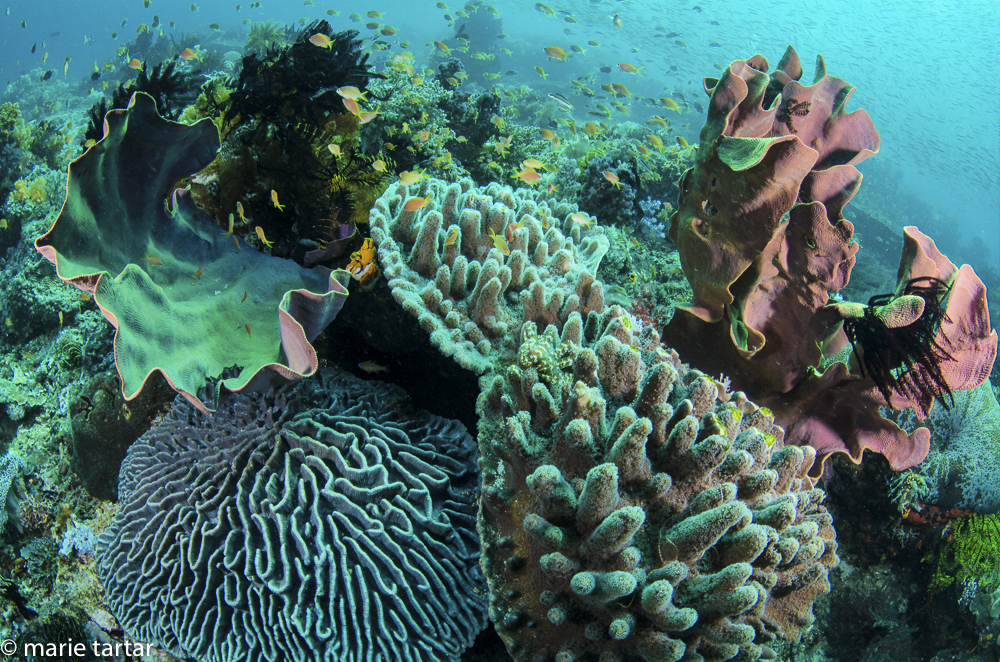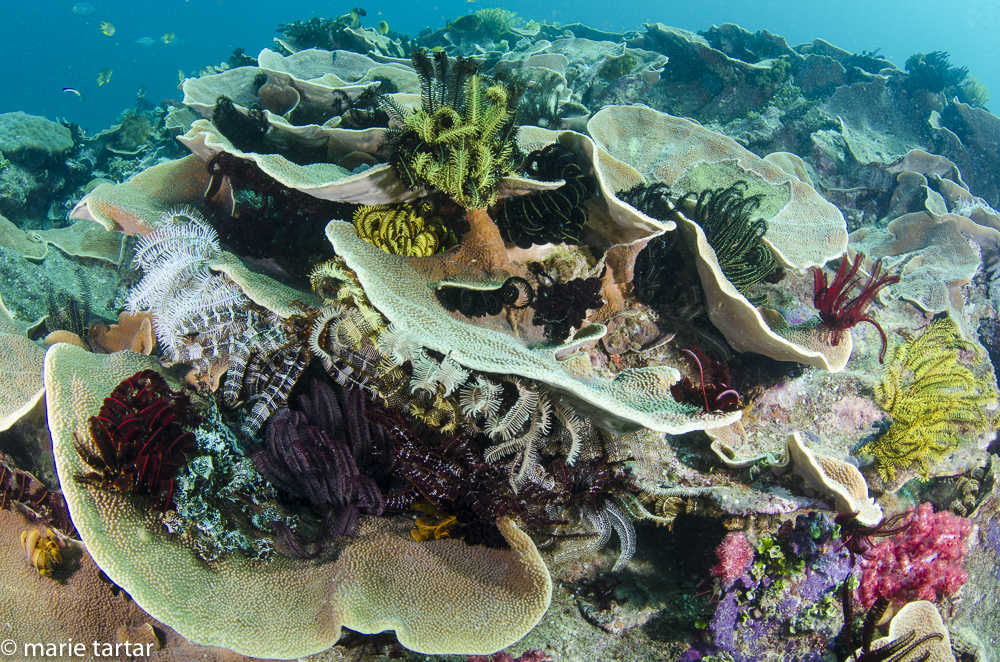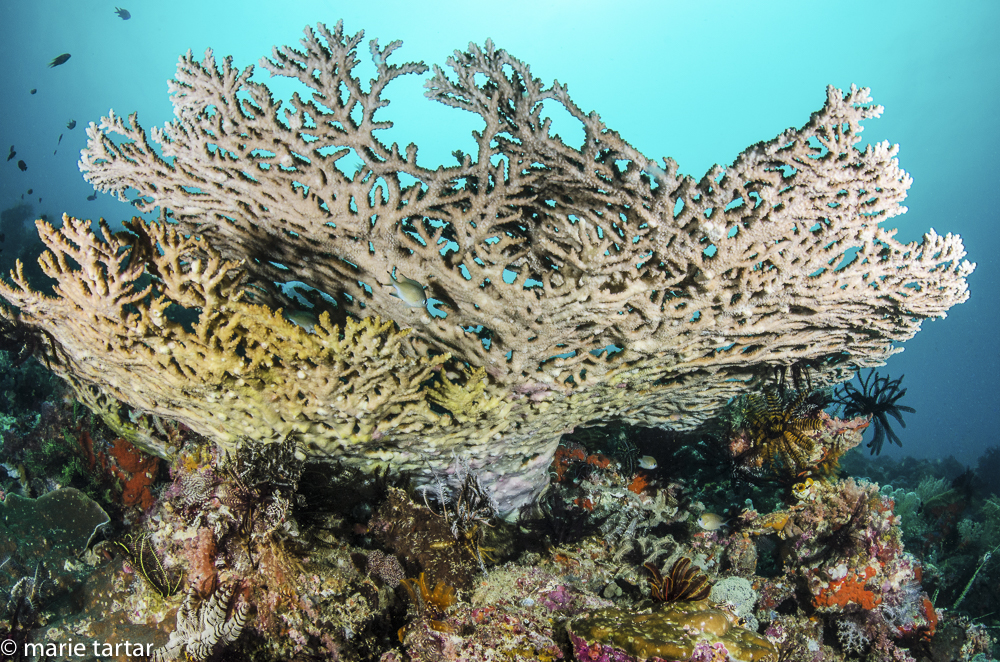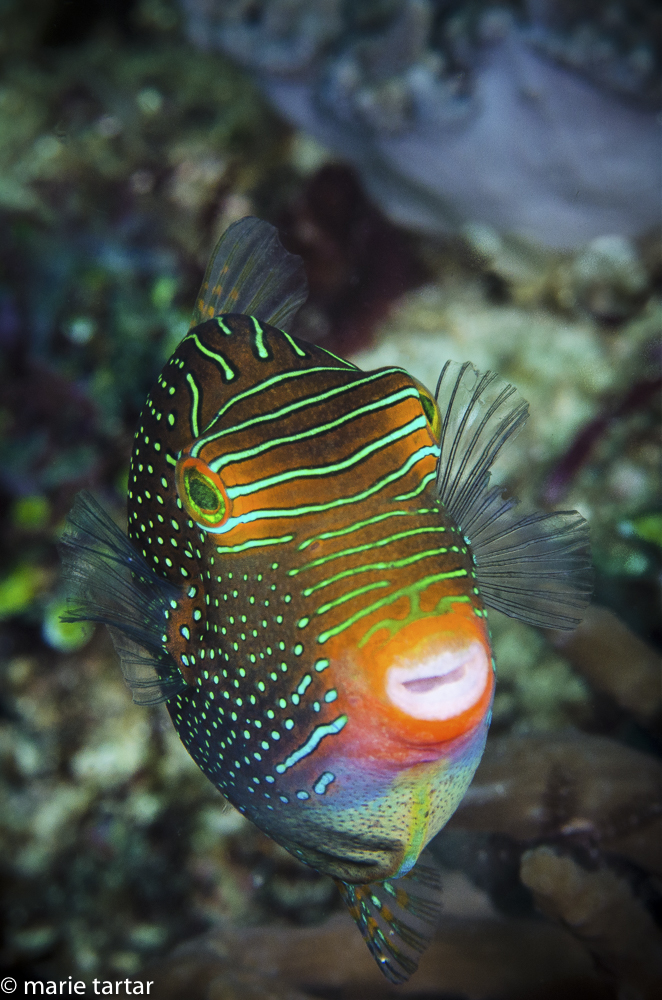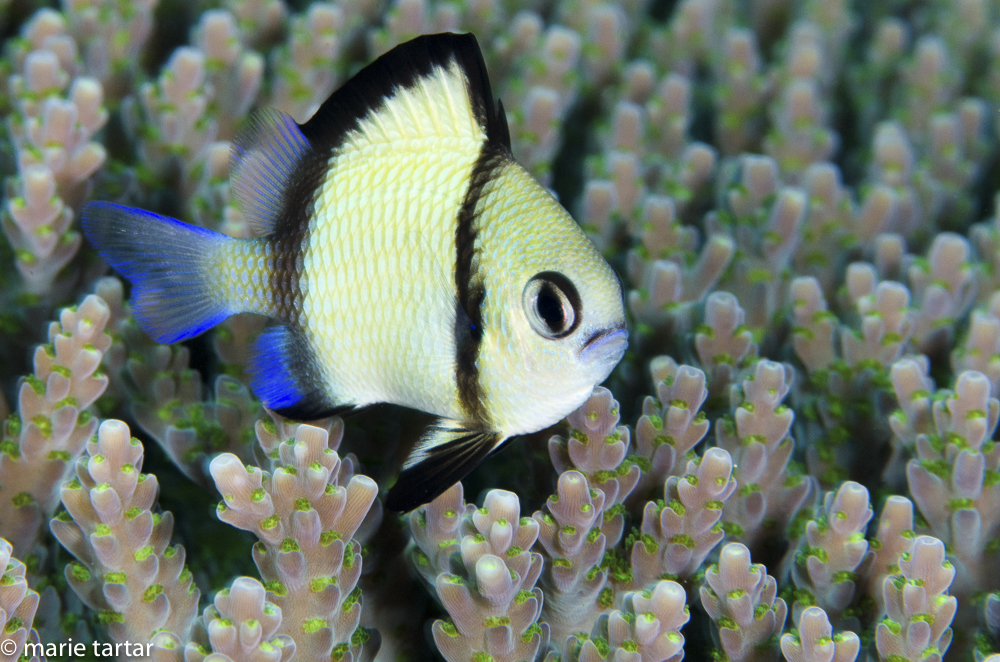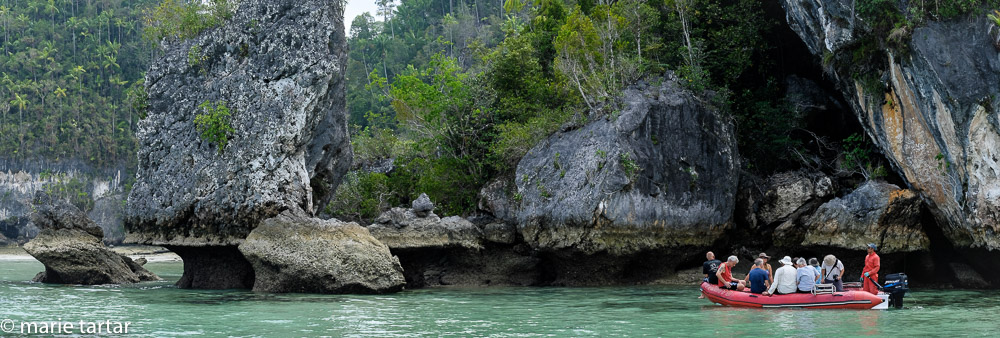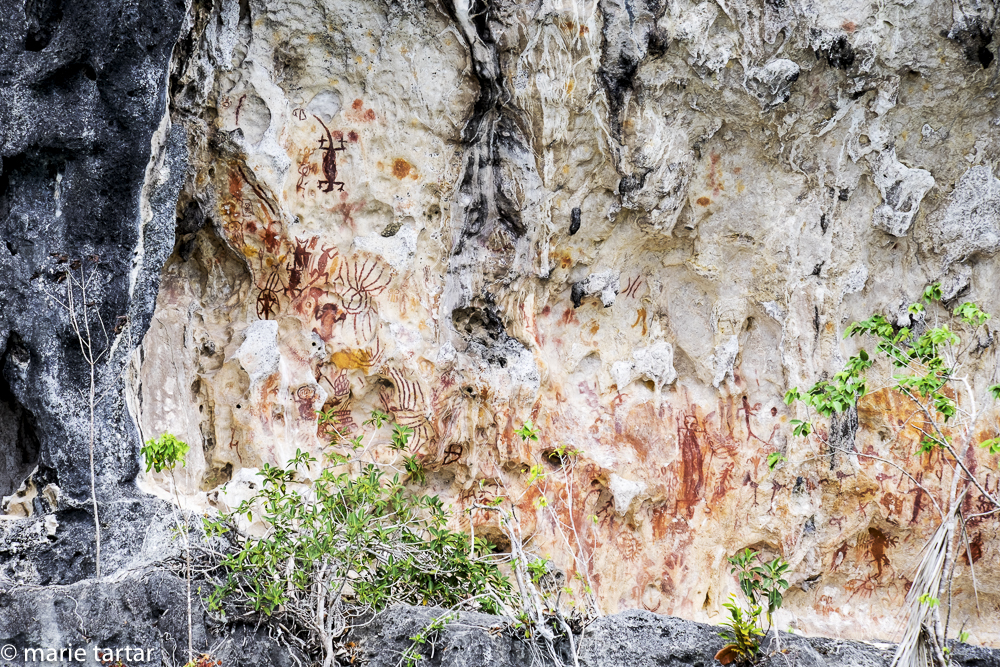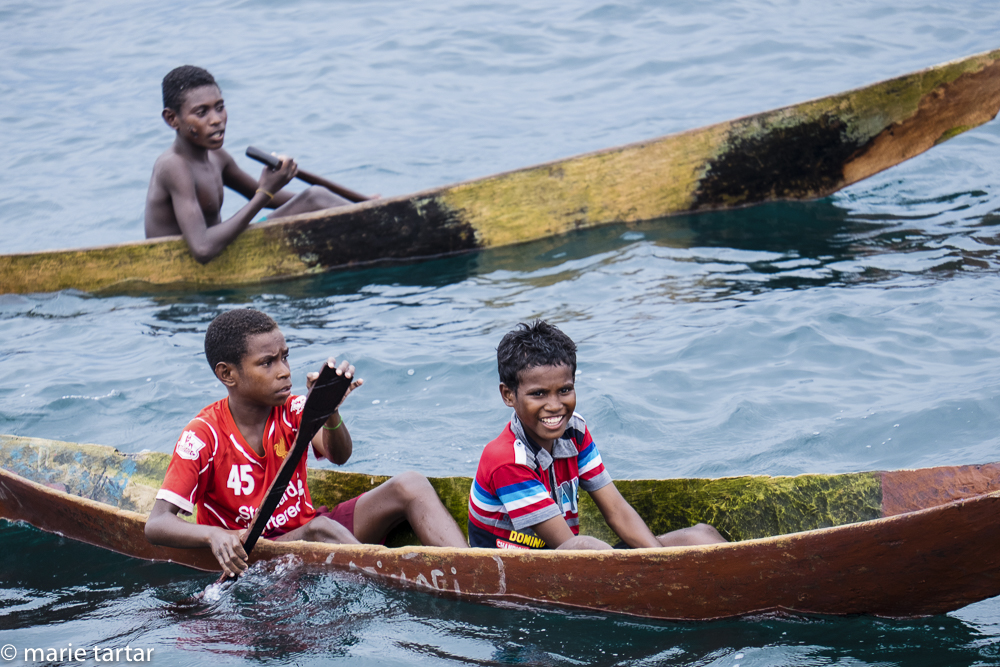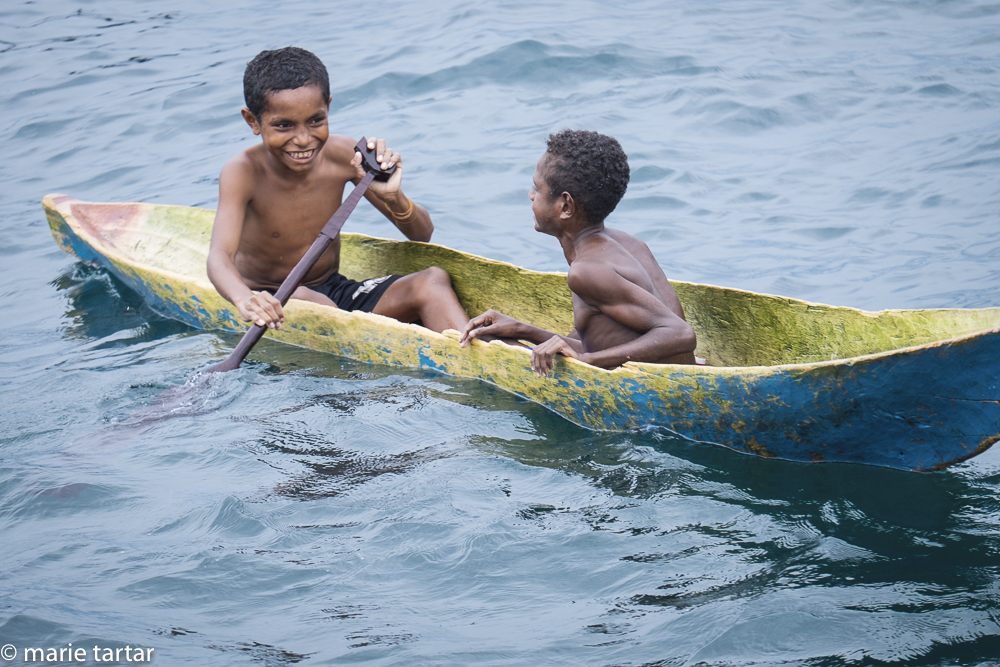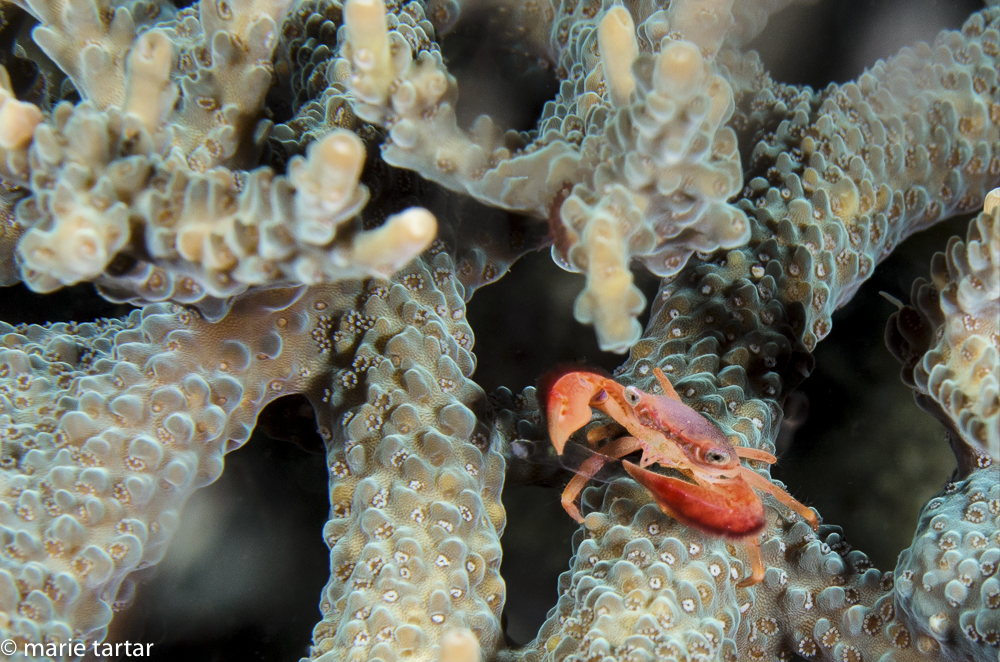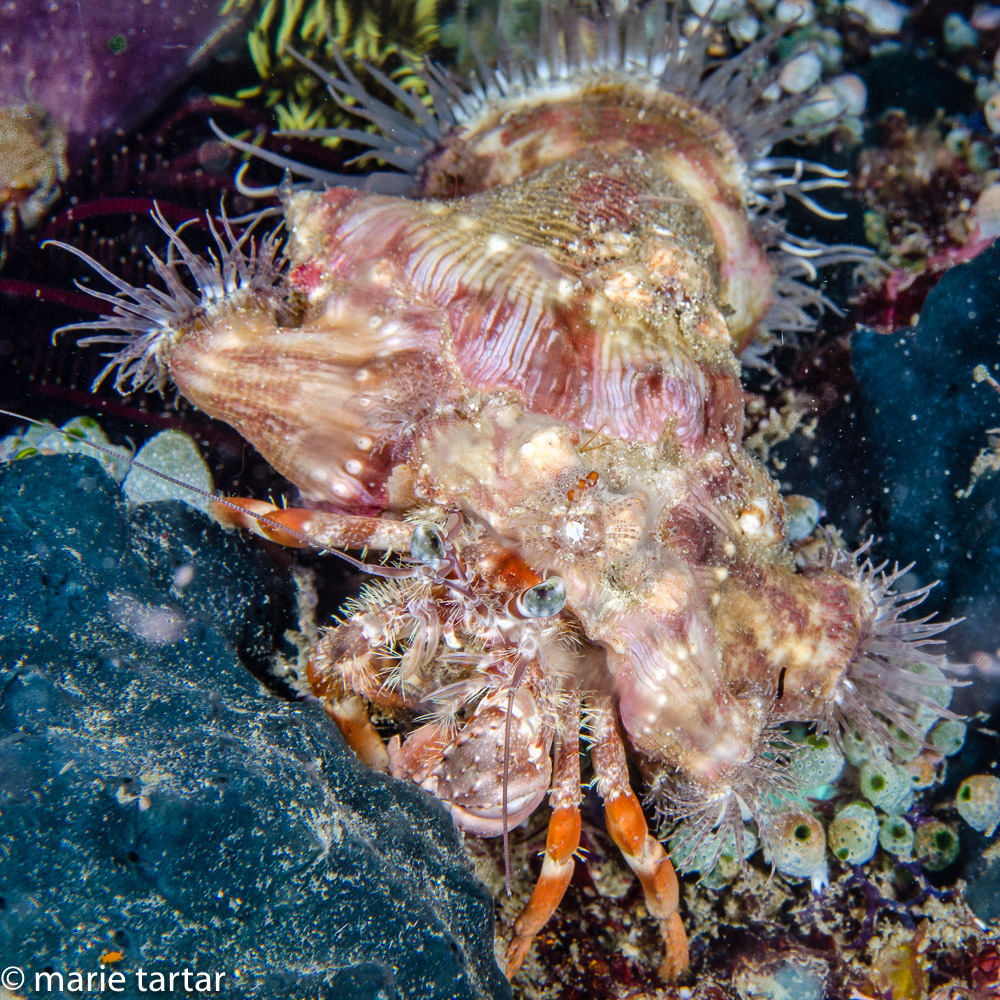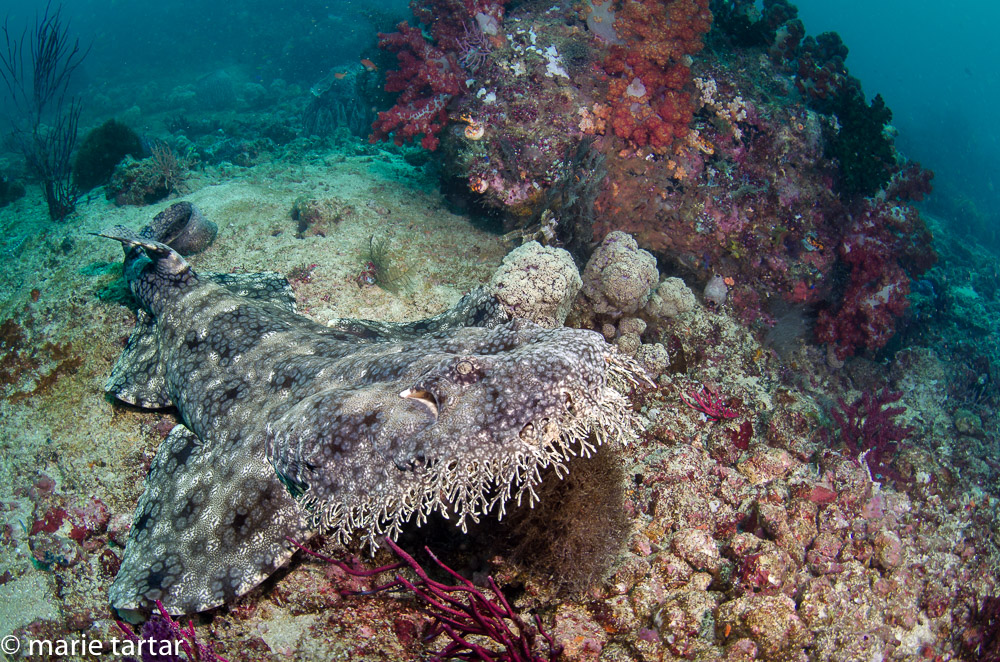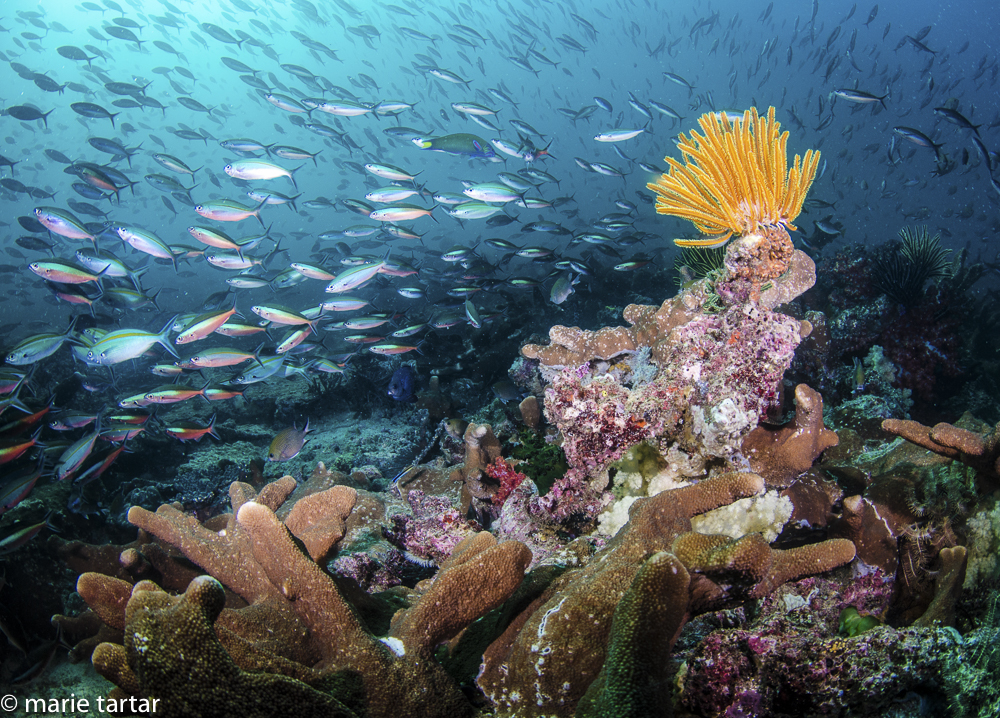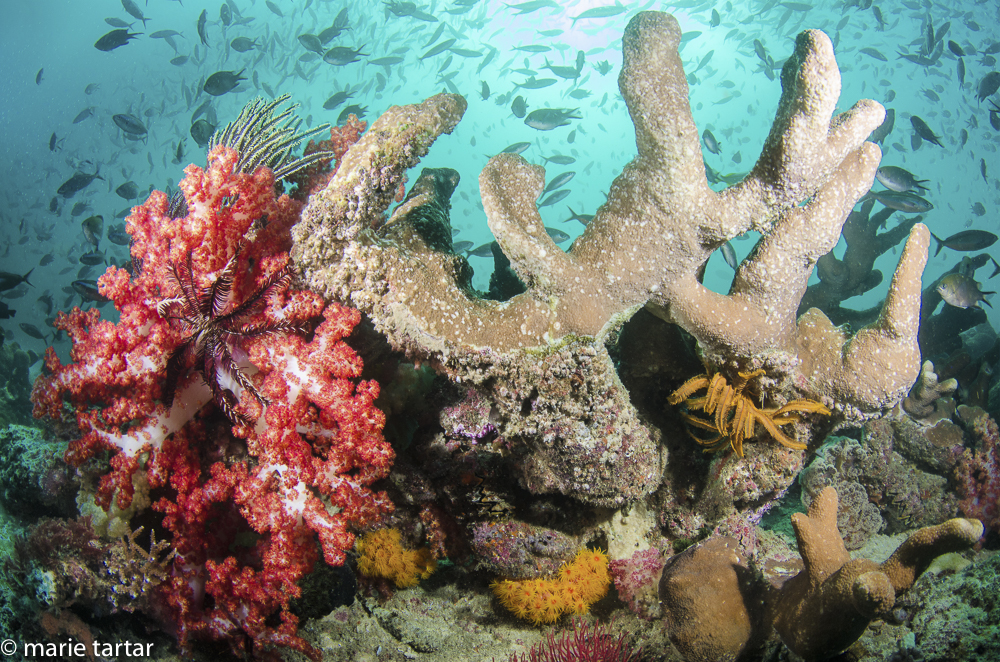
Saturday, October 31, 2015: Pisang Island, Maluku
Earlier in the trip, it seemed not at all certain we would make it here. Pisang is en route to Triton Bay. Apparently, villagers in the Triton Bay area were disgruntled, feeling they were not receiving their due from payments made by dive operators to the tourism office . Negotiations were underway, with the aid of the owner of Triton Bay Dive Resort. Burt, Herg and Kerri had been in contact with her for updates. The status seemed promising enough that we were en route, diving along the way, although days earlier this had seemed iffy.
Our first dive was T-Bone, and the second a large football field-sized plateau, The Dome. Steve found a lovely little orangutang crab on a great negative space. I saw several sharks, including a pair of babies. Steve banged his tank to get my attention when a manta swam over my head, but I didn’t see it. Lea pointed out a large lobster to me, rubbing her stomach afterwards, making me think she was saying it was pregnant. I swam down to inspect it, not sure how pregnancy would manifest in a lobster. It turns out she was saying “Yummy!”
I, as well as others, noticed a lot of likely macro subjects on The Dome, and elected to switch to macro for the third dive and return there with Ronan. Ronan seems to confound Macroscopic with Microscopic and showed us a series of nearly invisible to the naked eye subjects, including a soft coral crab and skeleton shrimp.
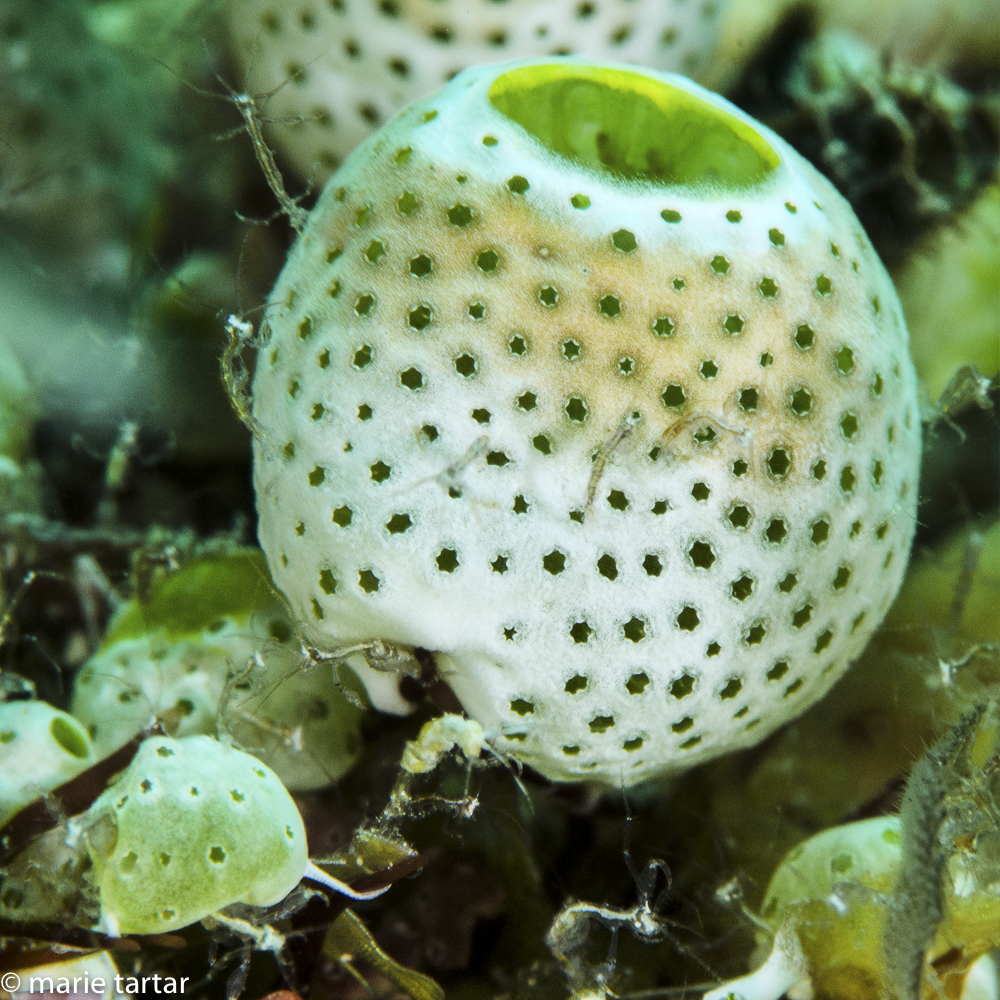
A world in miniature: the polka-dotted “olive”-shaped animal is an ascidian or sea squirt, (specifically: Didemnum molle), a filter feeder; the tiny, nearly translucent stick figures (and there are many in this shot) are skeleton shrimp (species Caprella)
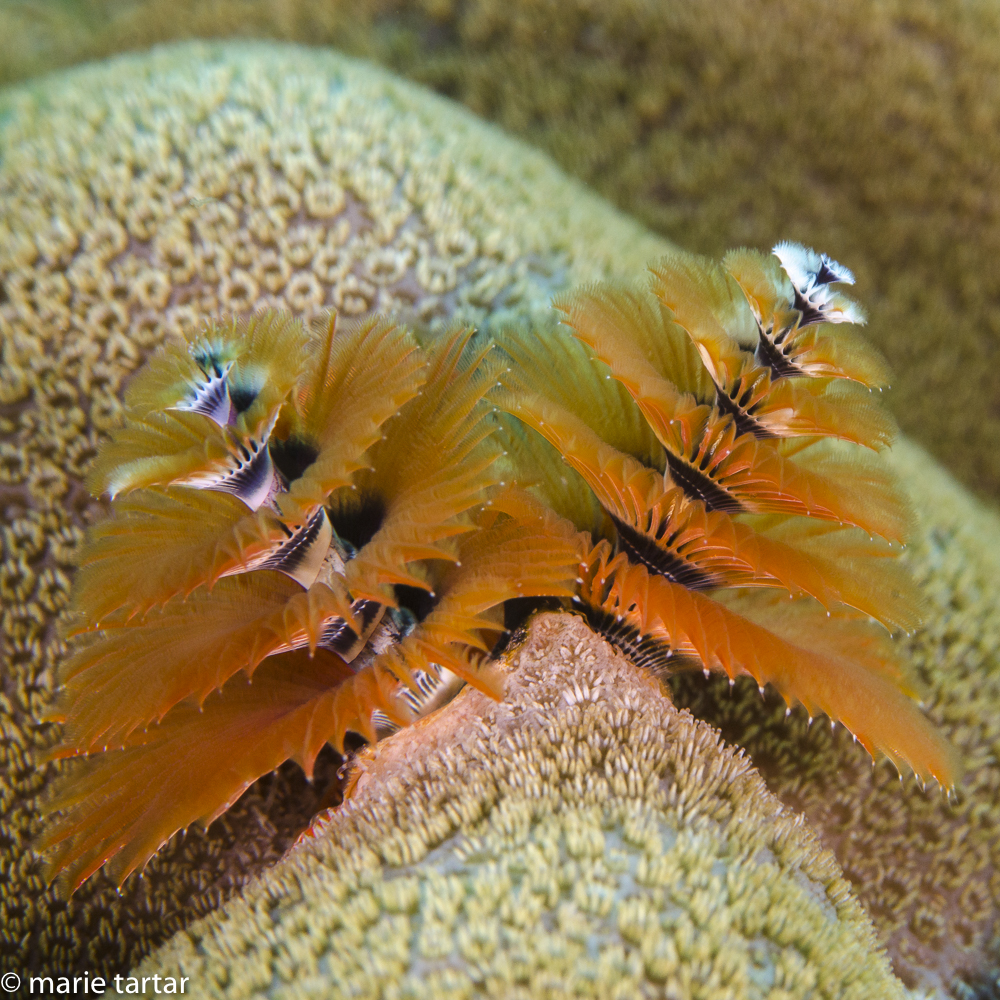
Feeding appendages of tiny Christmas tree worms (Spirobranchus giganteus); approach too closely and they suck back instantaneously out of sight
The evening’s entertainment was provided by Greg, in the form of the Melissa McCarthy comedy, “Spy.”
Sunday, November 1, 2015 found us still in transit to Triton Bay. We spent the morning diving near the island of Mommon at a site which proved to be unexpectedly nice. Burt had dove here years before, but was not encouraging. His briefing indicated that wide angle shooters likely would not find much to shoot, so most did macro for the first dive.
The site actually was unexpectedly attractive, with large groupers and bommies, including one with a spectacular population of glassy sweepers, on either side of a lovely projecting barrel sponge with soft corals and crinoids, like a grandly festooned lady’s hat of a past era.
He was so enthusiastic after our first dive that camera rigs were switched to wide-angle, and plans for a boatload not to dive in favor of a waterfall excursion were shelved.
Monday, November 2, 2015
Triton Bay
Not surprisingly, our arrival to Triton Bay and negotiations with the locals did not go entirely smoothly. Burt was up at 4:30 am and went to the indicated village for the requisite permission. However, there he was told that he needed to go to another village, pay the fees, and bring back the receipt. At the second village, he was told that the official who could do this transaction was away, in yet another village half an hour by boat away, attending a wedding. Another plan was cooked up, in which a speed boat would be sent to the wedding village with the son of the official.
In the meantime, there was a cruise in a skiff with 5000-7000 year old rock art, found on the mainland opposite Namatote Island, the work of wandering aborigines crossing Australia’s Torres Strait across what is now the shallow muddy Arafura Sea.
Late morning, we finally had permission and could suit up for a local macro dive. In the boat, my weight pockets were mixed up with Steve’s. We both figured this out later underwater, me having to inflate my BCD with an unprecedented amount of air to limp along the bottom, while Steve had to fight to stay down. Kerri showed me an adorable small anemone with clownfish, with which I was happily occupied, when she later returned, gesturing that a blue-ringed octopus had been found downslope. I arrived to find Lea and Greg. A tiny brown blob was indeed an unusually purple blue-ringed octopus. Greg found a second at the same site, while I was occupied with the first.
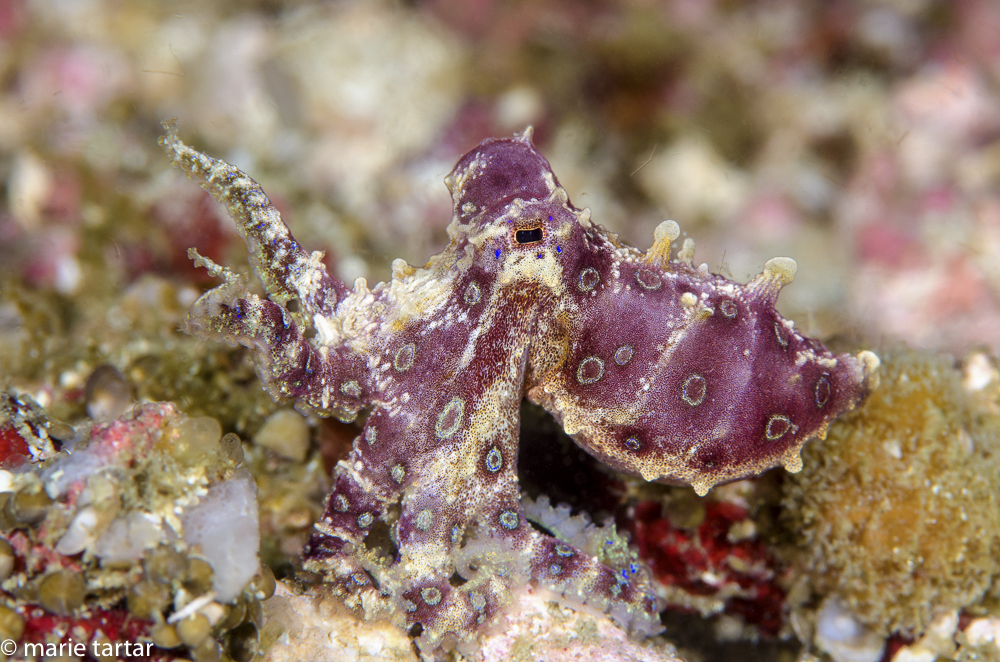
A tiny, potentially deadly blue-ringed octopus (Hapalochlaena sp.) A bite, with delivery of deadly tetrodotoxin, can kill within minutes. Fortunately, the wee beak of this tiny creature makes this unlikely.
After lunch, it emerged that perhaps the negotiations were ongoing.
While this was dragging on, boys from the nearby villages rowed out in their colorful dugout canoes to check us out. Their antics kept me, Greg and Phil entertained while the negotiations were ongoing.
Eventually, Herg called the chief’s bluff, saying that the boat would depart if the required paperwork were not in hand in 30 minutes. Twenty-nine minutes later, a skiff-borne party came on board to settle the matter in time for a dusk into night dive at Bo’s Rainbow.
The dive was unusually cold, with a pervasive current that made swimming seem like an uphill slog, yet didn’t carry us off. Our lights attracted great clouds of baitfish which pelted us bodily, one even committing harakiri by lodging itself in Brenda’s strobe arms. I found a tiny squat lobster at the base of a yellow crinoid, but wasn’t particularly enjoying the dive until Kerri pointed out a tiny bobtail squid in the sand. Its iridescence had drawn her attention.
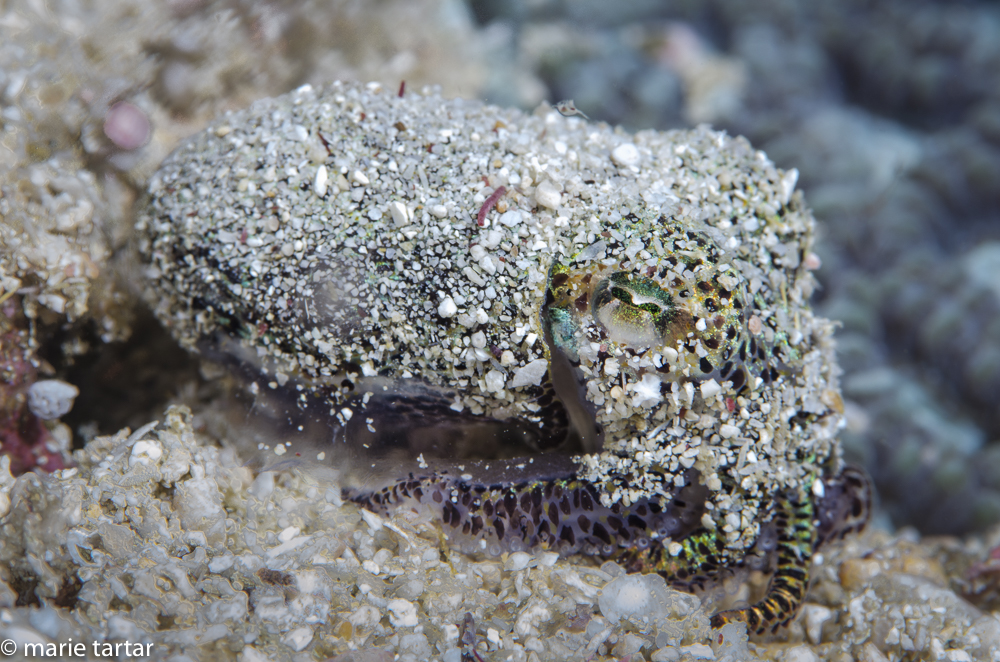
Tiny bobtail squid has several interesting strategies for evading predation. It spends its days buried in the sand and hunts at night. Once detected, it usually (as here) “glues” sand to itself via a mucus coat. It also harbors light-emitting bacteria in a special organ in its mantle. When moving about at night, light emitted by the bacteria (which it nourishes) “cloak” its movements from predators lurking below, eliminating its shadow and mimicking moonlight
Tuesday, November 3, 2015
Brrrrr! The subjective cold of the night dive was confirmed the following morning, our first full day in Triton Bay. My computer read 77 degrees F, 4 full degrees cooler than before!
I shot wide angle for the morning dives at Little Komodo near Aiduma, determined to put to use Herg’s tutorial of the prior day on wide angle lighting. Generally, the goal is simulation of the sun as a natural light source, by placing strobes above the subject. But getting them into position to light the subject without lighting particulates in the water is no easy task.
Burt’s briefing mentioned a particular danger of this site. We were diving in the lee of a small island, with a small islet at one corner, which marked a site of potentially strong current and eddy formation. I was to experience this as the abrupt end of my second dive. I had spent both dives in the colorful shallows, practicing lighting soft corals and colorful bouquets of corals, crinoids and sponges. I saw Ronan toward the end of the second dive, cruising by on his way to the corner. I decided to go the same way, but found myself sucked deeper, deeper, deeper in a maelstrom of swirling bubbles. The numbers flashing new depths on my computer sounded the alarm: 25 feet, 28 feet, 32 feet, 36 feet, 42 feet, 51 feet, 64 feet, 75 feet, 81 feet, 82 feet, 83 feet! It was hard not to breath faster, compounding my rising alarm. I remembered Burt and Herg saying not to add air to the BCD, lest one become a projectile rising to the surface when the current released its grip. But I had spent my whole dive in the shallows and had essentially no air in my BCD when my wild ride began. So, I added a few brief bursts of air which I had to release just as quickly when the current relented and I began rising. I had been kicking, to no avail, as the force of the spinning water was irresistible. It was a scary downcurrent, one of the fastest I’ve ever experienced. I was surprised that I was reasonably calm, probably because I knew I had plenty of air. I just kept telling myself that the eddy would let go of me eventually. Thankfully, it did so-any deeper would have really tested my freak out threshold.
The afternoon was more calm, at the site of our prior night dive, Bo’s Rainbow. For me, it was a continual struggle with wide angle lighting, wrestling with the clamps and trying to maneuver the strobe arms into a position to light my subject, without lighting scatter in the water column. Then, results check, adjust strobe strength and/or position, then repeat. And so on. The current was strong, as before.
Our evening dive was before dinner at Macro Rocks.
Markus, Steve, Greg and I went with Ronan, who found multiple tiny subjects, including one about which he was particularly stoked , a hairy shrimp.
I was thrilled to find my own tiny bobtail squid, a pair of large iridescent eyes bobbing over the sand catching my eye.
Wednesday, November 4, 2015
We awoke to banging doors and shouts. This proved to be due to a mola-mola on the surface, which came up to the boat. Greg, Doug and Brenda were snorkeling in the water, too late for the mola-mola, but shooting moon jellies in the shallows in a light rain.
Our first dive was delayed, as the potential for whalesharks was investigated. Herg visited 3 bagans, where bait fish are harvested. One had fish, and the whalesharks, if they came to feed, usually came between 8 and 9 am.
While we were hanging out in the dining room, the conversation was free-ranging, and yielded some enticing tidbits. Regarding tattoos, we learned the term “tramp stamp” for tattoos above the buttocks, while Markus offered the European version, “ass antlers.” Greg recalled a workman he knew who had a swastica tattooed on a bicep at age 16, apparently never having learned about WW II and Hitler in school.
He had it transformed later into a window.
9 am came, and no whale sharks, so on to the dive day. Our first dive was a return to Bo’s Rainbow, a beautiful wide angle site, despite the grey overcast and rain. There were tiny baitfish in the shallows.
My best sighting was a small banded sea snake, no match for my wide-angle rig. I tried to show it to Steve, who did have a macro set-up, but despite it remaining essentially stationary for 10 minutes after I first sighted it, it disappeared into a soft coral forest when I returned with Steve.
During the second dive at Little Komodo (Aiduma Island), Greg came to find me to show me a wobbegong shark, resting in a colorful, soft-coral encrusted mini-canyon, limiting the access. After shooting the head end, and trying the tail end, thankfully, it rose up and swam off, resting down reef near a small bommie, with much better access.
Our late afternoon and after dinner night dives were at the same rubble and sand-bottom site, C.I. Beach (Conservation International) with small clumps of corals, miniature islands of life in a sea of sand and rubble.
I experienced first hand the indignity of being used as a human tripod, a story Greg tells of a crusty octogenarian named Herman, while shooting a pair of crab-eye gobies under a small ledge. Complicating the shoot was a pair of light blue Cressie fins descending onto my head from above, frantically finning, then stabilizing on my head, with an occasional sand storm raining down into the field.

Crab-eye goby pair (Signigobius biocellatus) derive their common name from the false eyes said to resemble stalked crab eyes, and their dark ventral fins suggesting crab pincers. I don’t really see the resemblance myself. Their mode of hopping sideways is quite characteristic and said to be a crab imitation. I don’t see that either, but they are quite striking
Returning at night, we entered in 10 feet of water, and the first bommie we encountered had a partially rolled up anemone, with multiple clownfish and a pair of porcelain crabs.
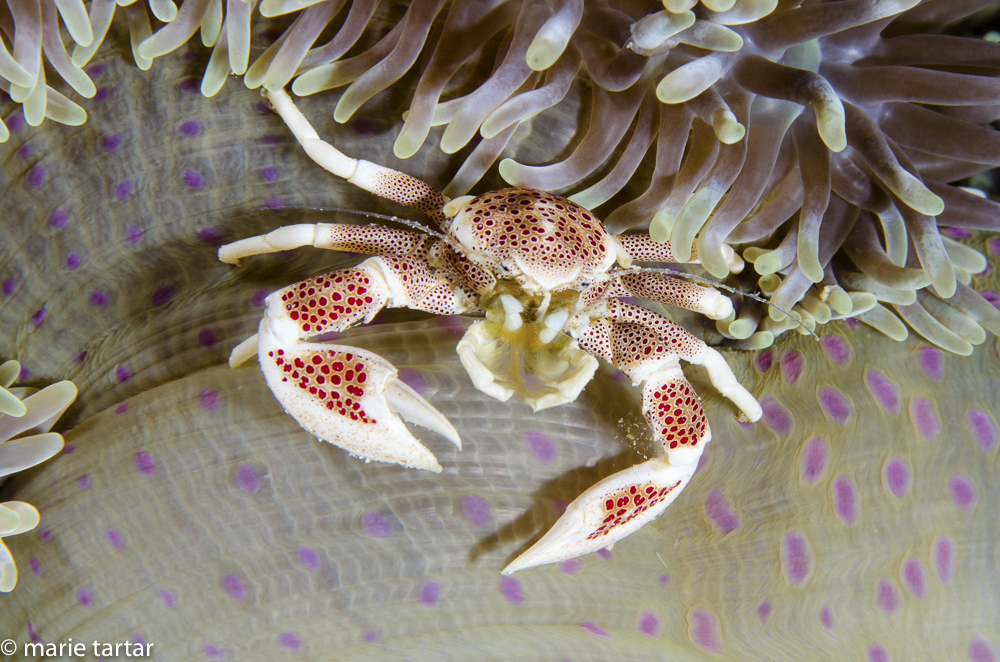
Spotted porcelain crab (Neopetrolisthes maculata) lives in the shelter of an anemone, Triton Bay, Indonesia
By the time I lifted my head up, I was alone in the dark with faint and distant lights down reef to indicate Eric, Greg and Markus had moved on.
Rejoining them, Greg showed me a a microscopic cockatoo waspfish on a miniature bommie , so tiny I didn’t even attempt to shoot it.
Eric’s frantically gesturing flashlight led me deeper, into 33 feet of water, across an expanse, but he was on a roll, showing me nudibranchs, skeleton shrimps, a passel of pipefish, a crocodile fish and finally a bulbous pair of aqua blue-green eyes buried in sand, another bobtail squid. I podded it out gently to complete a great night dive.
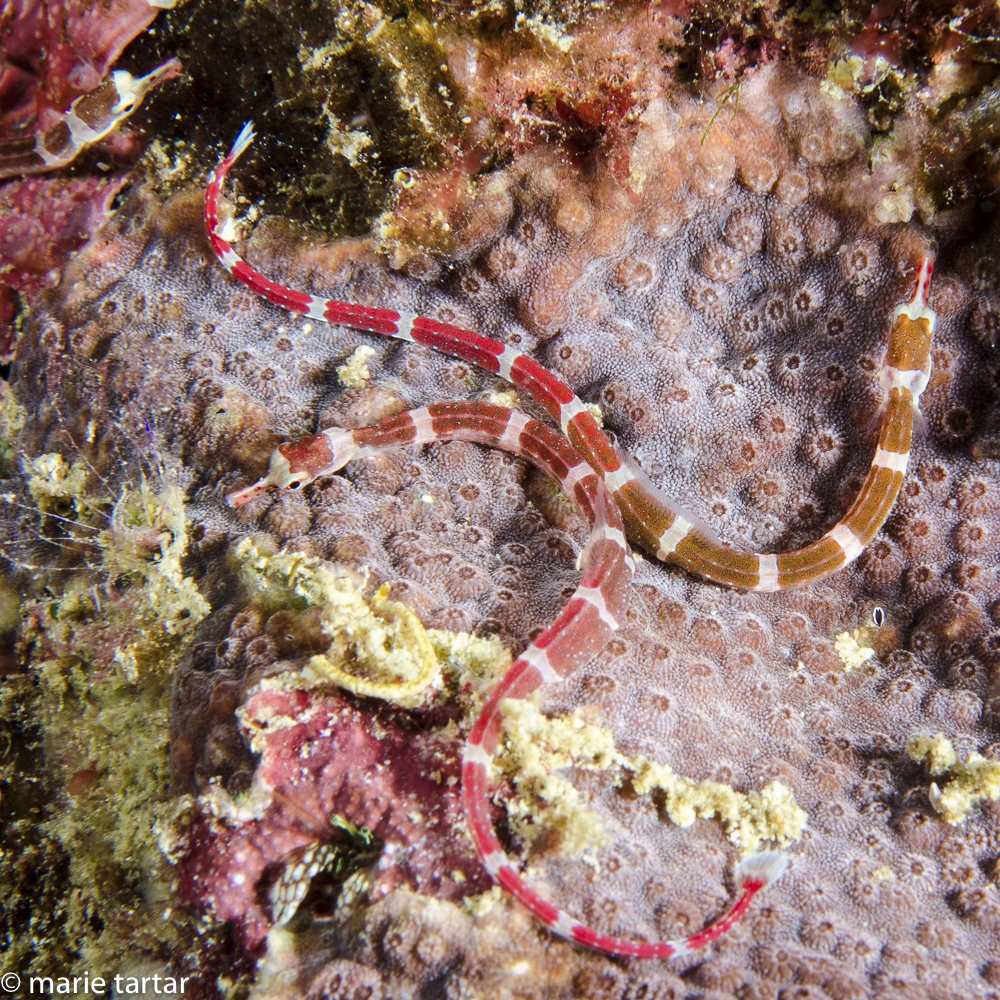
A passel of brown-banded pipefish (Corythoichthys amplexus) hunting at night in Triton Bay, Indonesia
Thursday, November 5, 2015
Hurry up and wait was the theme of the morning. The report from the bagans was that whale sharks had visited at dawn, but they hadn’t fed them or kept them around.
A new plan was formulated for the following morning, an early morning whale shark excursion.
The morning was occupied by a whale watching excursion. Whales were sighted in the distance, so into 2 skiffs we loaded, one a dry boat for land camera toters and the other a wet boat for a group that wanted to try to get into the water with the whales. Knowing the odds for this were low, I opted to go in the dry boat, but hedged my bets by sending my snorkeling gear in the wet boat, just in case we happened on a cooperative animal. It proved to be a pair of Bryde’s whales, feeding.
The water’s surface was bubbling with fish activity, which was our clue where they might next surface momentarily . The snorkelers did slip into the water a few times, and were rewarded with a swim-by. Along the way, dolphins jumped out of the water a few times, but we only had eyes for whales, so paid little attention. A marlin waved its dorsal fin on the surface, feeding, but disappeared quickly.
Our first dive near Orembai Island was in the afternoon and was spectacular! Great stands of staghorn coral, with thick and near continuous dense schools of fish as a backdrop.
Our late afternoon dive to Flasher Beach, near Lanzaro Island, had as its attraction an unusual population of flasher wrasses, found over a rubble substrate at 70 feet of depth. The males of this gorgeous small and elusive group of fishes “flashes” momentarily its regal plumage as a mating display (the aquatic equivalent of a little leg while wrangling for a pick-up as a hitchhiker). This site is unusual both for the number of this species and for interbreeding, leading to variations found no where else. Burt warned us shooting them would be an exercise in frustration. I watched them with interest for a few minutes before deciding it was futile. More to my liking was a small anemone with a population of tiny clownfishes.
Kerri found a pair of Lovely Headshield Slugs (Chelidonura amoena) on a coral perch.

Lovely headshield slug (Chelidonura amoena) pair in an amorous trist; this colorful appearing substrate resembled a bland field of pottery shards to the eye
Flasher Beach was also the site of the night dive, which I opted to skip. Greg came back with shots of a red abalone, which it took digging out a reference book to confirm.
Friday, November 6, 2015
The wake-up bell was rung early, 4:30 am, when it was still deep dark. The 3 local pagans kept back some fish from their early morning collections to attract and hopefully, feed, whalesharks. Our 3 skiffs were deployed to the 3 bagans, floating wooden platforms ringed by nets, on which a small fisherman crew lives and works. We were in radio contact with each other, lest only one be visited by whalesharks, but to no avail.
The rest of the day we were underway to the Banda Sea. For us, we were at leisure, with time for napping, image processing, a workflow presentation by Hergen and in the evening, Ronan kept us awake while narrating a film of the building of the Pindito. The name derives from Pinisi Diving Tourism, with pinisi being a traditional Indonesian wooden boat. It was handbuilt of incredibly dense ironwood over 10 months in dry dock in Kalimantan, starting with a crew of 15 woodworkers, swelling to 80 workers by the end.
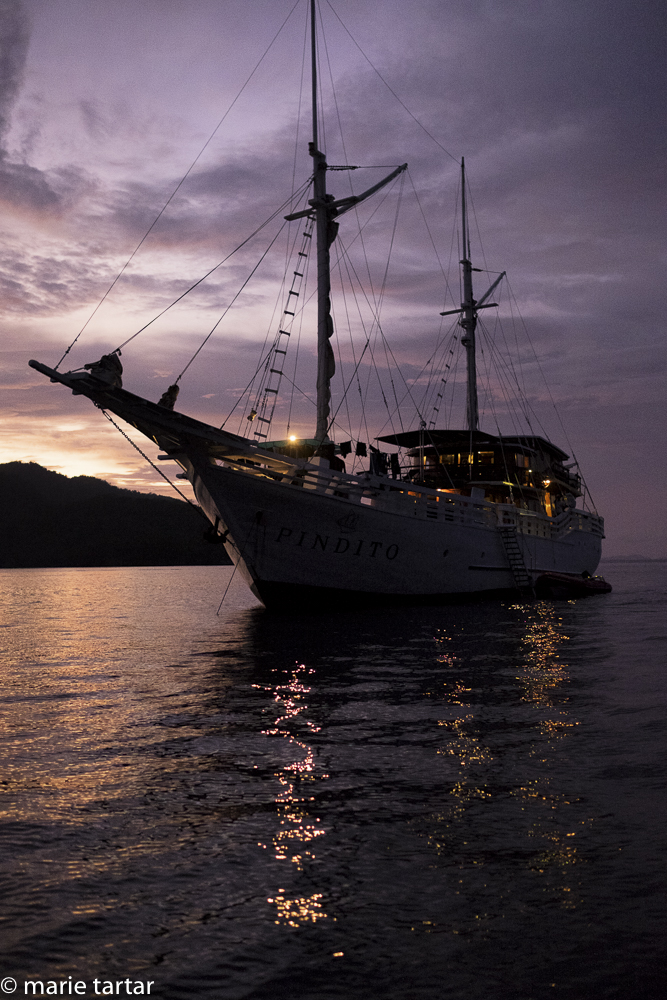
Our home for 17 wonderful days in remoter corners of Indonesia, Pindito, one of the first liveaboards to explore Raja Ampat
Next stop-the Banda Sea and Ambon, a rival to Lembeh for the crown of macro capitol of Indonesia! Stay tuned…
-Marie

